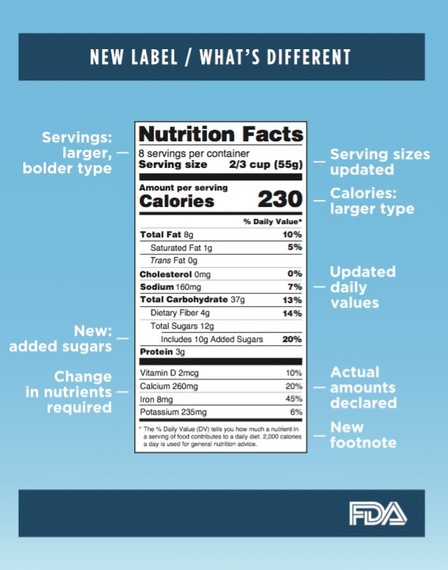Have you ever wondered why there are carbs in meat like frankfurters, bologna or other processed meats? Or why your blood glucose levels go up higher than usual after eating these foods? Hidden sugar is most likely the cause. Often times, food manufacturers list these ingredients using unfamiliar terms like maltose or levulose. Adding to the confusion, the current Nutrition Facts label doesn't distinguish between added sugars and naturally occurring sugars.
But that's about to change. The U.S. Food and Drug Administration finalized a new Nutrition Facts label that will make it easier for you to identify and compare products with added sugar and enable you to make healthier choices. This is the first major overhaul of the Nutrition Facts label since 1993. The changes are scheduled to be made over the next two to three years. So, by the end of July 2019, manufacturers will be required to list added sugars separately from naturally occurring sugars. Added sugars will no longer be hidden, they will be listed under Total Sugars.
As a reminder, naturally occurring sugars come with many nutritional benefits like the fiber in fruit and the calcium in milk, and can be part of a healthy diabetes meal plan. On the other hand, when manufacturers add sugar to foods they're not increasing nutritional value, just boosting calories.
Added sugars are not the only change to the label. Registered dietitian nutritionist and Spokesperson for the Academy of Nutrition and Dietetics, Lori Zanini breaks down the other changes you'll find on the new Nutrition Facts label:
Serving Size
"Our understanding of a 'serving size' has changed over the years. The new label now lists serving size as what is typically eaten in one sitting. This new format will help by easing or even eliminating the need to multiply several servings and daily value percentages to know how much has been consumed," Zanini said.
For instance, the serving size on a 12-ounce beverage will now be listed as one serving, since a person typically drinks the whole amount at one time. "People should also know that the serving size does not necessarily reflect the recommended portion size. The MyPlate guidelines are a great resource for understanding proper portion sizes," Zanini said.
Nutrients and Ingredients
Several changes to the label have been made to better reflect people's adequate, under- or over-consumption of vitamins, nutrients and ingredients:
• Vitamin A and C will no longer be listed on the label because, in general, Americans do not have difficulty getting the recommended amounts of these vitamins.
• Vitamin D and potassium will now be listed, since they are two key nutrients Americans need for bone and heart health, respectively. "Many people do not consume these nutrients in sufficient amounts," Zanini said.
Percent of Daily Values
"The percent Daily Values (DV) help evaluate how a particular food fits into a person's daily meal plan," Zanini said. With the newly adjusted serving sizes on the Nutrition Facts Panel, percent Daily Values will be easier to calculate:
• Daily Values are average levels of nutrients for a person eating 2,000 calories a day. A food item with a 5 percent DV of sodium provides 5 percent of the total sodium that the person should eat each day.
• Percent DV are for the entire day, not just one meal or snack.
• Aim for high DVs (20 percent or more) in vitamins and minerals, such as vitamin D and potassium and low (5 percent or less) in added sugars and sodium.
• Following the Dietary Guidelines, the updated percent Daily Value for added sugar is based on the recommendation that daily intake of calories from added sugar not exceed 10 percent of total calories.
If you've attempted to read the Nutrition Facts label in the past and failed to understand the information, then you're not alone. "Many grocery stores now have registered dietitian nutritionists on staff to help their customers understand how to read labels and select the right foods for their customers' healthy eating plans," Zanini said.
Click here to find a registered dietitian nutritionist near you.
The infographic below shows what's different on the new Nutrition Facts label.
